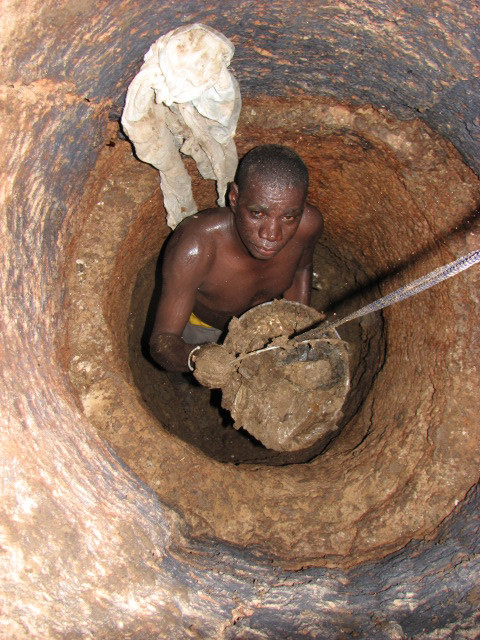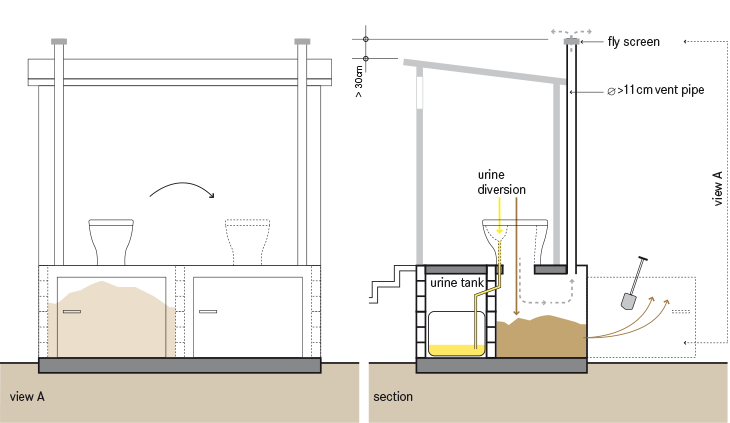|
Manual Scavenging
Manual scavenging is a term used mainly in India for "manually cleaning, carrying, disposing of, or otherwise handling, human excreta in an insanitary latrine or in an open drain or sewer or in a septic tank or a pit". Manual scavengers usually use hand tools such as buckets, brooms and shovels. The workers have to move the excreta, using brooms and tin plates, into baskets, which they carry to disposal locations sometimes several kilometers away. The practice of employing human labour for cleaning of sewers and septic tanks is also prevalent in Bangladesh and Pakistan. These sanitation workers, called "manual scavengers", rarely have any personal protective equipment. The work is regarded as a dehumanizing practice. The occupation of sanitation work is intrinsically linked with caste in India. All kinds of cleaning are considered lowly and are assigned to people from the lowest rung of the social hierarchy. In the caste-based society, it is mainly the Dalits who work as sanitati ... [...More Info...] [...Related Items...] OR: [Wikipedia] [Google] [Baidu] |
Human Waste
Human waste (or human excreta) refers to the waste products of the human digestive system, menses, and human metabolism including urine and faeces. As part of a sanitation system that is in place, human waste is collected, transported, treated and disposed of or reused by one method or another, depending on the type of toilet being used, ability by the users to pay for services and other factors. Faecal sludge management is used to deal with fecal matter collected in on-site sanitation systems such as pit latrines and septic tanks. The sanitation systems in place differ vastly around the world, with many people in developing countries having to resort to open defecation where human waste is deposited in the environment, for lack of other options. Improvements in "water, sanitation and hygiene" (WASH) around the world is a key public health issue within international development and is the focus of Sustainable Development Goal 6. People in developed countries tend to use flu ... [...More Info...] [...Related Items...] OR: [Wikipedia] [Google] [Baidu] |
Toilet
A toilet is a piece of sanitary hardware that collects human urine and feces, and sometimes toilet paper, usually for disposal. Flush toilets use water, while dry or non-flush toilets do not. They can be designed for a sitting position popular in Europe and North America with a toilet seat, with additional considerations for those with disabilities, or for a squatting posture more popular in Asia (see squat toilet). In urban areas, flush toilets are usually connected to a sewer system that leads to septic tanks in isolated areas. The waste is known as '' blackwater'' and the combined effluent including other sources is sewage. Dry toilets are connected to a pit, removable container, composting chamber, or other storage and treatment device, including urine diversion with a urine-diverting toilet. The technology used for modern toilets varies. Toilets are commonly made of ceramic (porcelain), concrete, plastic, or wood. Newer toilet technologies include dual flushing, ... [...More Info...] [...Related Items...] OR: [Wikipedia] [Google] [Baidu] |
Sanitation Workers
A sanitation worker (or sanitary worker) is a person responsible for cleaning, maintaining, operating, or emptying the equipment or technology at any step of the sanitation chain.World Bank, ILO, WaterAid, and WHO (2019)Health, Safety and Dignity of Sanitation Workers: An Initial Assessment World Bank, Washington, DC. This is the definition used in the narrower sense within the WASH sector. More broadly speaking, sanitation workers may also be involved in cleaning streets, parks, public spaces, sewers, stormwater drains, and public toilets. Another definition is: "The moment an individual’s waste is outsourced to another, it becomes sanitation work." Some organizations use the term specifically for municipal solid waste collectors, whereas others exclude the workers involved in management of solid waste (rubbish, trash) sector from its definition. Sanitation workers are essential in maintaining safe sanitation services in homes, schools, hospitals, and other settings and prote ... [...More Info...] [...Related Items...] OR: [Wikipedia] [Google] [Baidu] |
Hindi
Hindi (Devanāgarī: or , ), or more precisely Modern Standard Hindi (Devanagari: ), is an Indo-Aryan language spoken chiefly in the Hindi Belt region encompassing parts of northern, central, eastern, and western India. Hindi has been described as a standardised and Sanskritised register of the Hindustani language, which itself is based primarily on the Khariboli dialect of Delhi and neighbouring areas of North India. Hindi, written in the Devanagari script, is one of the two official languages of the Government of India, along with English. It is an official language in nine states and three union territories and an additional official language in three other states. Hindi is also one of the 22 scheduled languages of the Republic of India. Hindi is the '' lingua franca'' of the Hindi Belt. It is also spoken, to a lesser extent, in other parts of India (usually in a simplified or pidginised variety such as Bazaar Hindustani or Haflong Hindi). Outside India, several ot ... [...More Info...] [...Related Items...] OR: [Wikipedia] [Google] [Baidu] |
Septic Tank
A septic tank is an underground chamber made of concrete, fiberglass, or plastic through which domestic wastewater (sewage) flows for basic sewage treatment. Settling and anaerobic digestion processes reduce solids and organics, but the treatment efficiency is only moderate (referred to as "primary treatment"). Septic tank systems are a type of simple onsite sewage facility. They can be used in areas that are not connected to a sewerage system, such as rural areas. The treated liquid effluent is commonly disposed in a septic drain field, which provides further treatment. Nonetheless, groundwater pollution may occur and can be a problem. The term "septic" refers to the anaerobic bacterial environment that develops in the tank that decomposes or mineralizes the waste discharged into the tank. Septic tanks can be coupled with other onsite wastewater treatment units such as biofilters or aerobic systems involving artificially forced aeration. The rate of accumulation of sludge— ... [...More Info...] [...Related Items...] OR: [Wikipedia] [Google] [Baidu] |
Dry Toilet
A dry toilet (or non-flush toilet, no flush toilet or toilet without a flush) is a toilet which, unlike a flush toilet, does not use flush water. Dry toilets do not use water to move excreta along or block odors. They do not produce sewage, and are not connected to a sanitary sewer, sewer system or septic tank. Instead, human excreta, excreta falls through a drop hole. A variety of dry toilets exist, ranging from simple bucket toilets to specialized Incinerating toilet, incinerating and Freezing toilet, freezing toilets. Types Types of dry toilet, listed in approximate order from simplest to most complex, include: * Bucket toilet – The most basic kind of toilet. May have a toilet seat, with or without a lid. May be accompanied by material (e.g. wood ash, sawdust, or quick lime) to cover excreta after use. * Pit latrine – excluding pour-flush versions with water seal * UDDT, Urine-diverting dry toilet – urine and feces urine diversion, collected separately * Composting to ... [...More Info...] [...Related Items...] OR: [Wikipedia] [Google] [Baidu] |
International Labour Organization
The International Labour Organization (ILO) is a United Nations agency whose mandate is to advance social and economic justice by setting international labour standards. Founded in October 1919 under the League of Nations, it is the first and oldest specialised agency of the UN. The ILO has 187 member states: 186 out of 193 UN member states plus the Cook Islands. It is headquartered in Geneva, Switzerland, with around 40 field offices around the world, and employs some 3,381 staff across 107 nations, of whom 1,698 work in technical cooperation programmes and projects. The ILO's standards are aimed at ensuring accessible, productive, and sustainable work worldwide in conditions of freedom, equity, security and dignity. They are set forth in 189 conventions and treaties, of which eight are classified as fundamental according to the 1998 Declaration on Fundamental Principles and Rights at Work; together they protect freedom of association and the effective recognition of the r ... [...More Info...] [...Related Items...] OR: [Wikipedia] [Google] [Baidu] |
Container-based Sanitation
Container-based sanitation (abbreviated as CBS) refers to a sanitation system where toilets collect human excreta in sealable, removable containers (also called cartridges) that are transported to treatment facilities. This type of sanitation involves a commercial service which provides certain types of portable toilets, and delivers empty containers when picking up full ones. The service transports and safely disposes of or reuses collected excreta. The cost of collection of excreta is usually borne by the users. With suitable development, support and functioning partnerships, CBS can be used to provide low-income urban populations with safe collection, transport and treatment of excrement at a lower cost than installing and maintaining sewers. In most cases, CBS is based on the use of urine-diverting dry toilets. A key benefit of container-based sanitation systems is its relative low-cost. In addition, the process assures there is no human contact with excreta. Feces can be co ... [...More Info...] [...Related Items...] OR: [Wikipedia] [Google] [Baidu] |
Urine-diverting Dry Toilets
A urine-diverting dry toilet (UDDT) is a type of dry toilet with urine diversion that can be used to provide safe, affordable sanitation in a variety of contexts worldwide. The separate collection of feces and urine without any flush water has many advantages, such as odor-free operation and pathogen reduction by drying. While dried feces and urine harvested from UDDTs can be and routinely are used in agriculture (respectively, as a soil amendment and nutrient-rich fertilizer—this practice being known as reuse of excreta in agriculture), many UDDT installations do not apply any sort of recovery scheme. The UDDT is an example of a technology that can be used to achieve a sustainable sanitation system. This dry excreta management system (or "dry sanitation" system) is an alternative to pit latrines and flush toilets, especially where water is scarce, a connection to a sewer system and centralized wastewater treatment plant is not feasible or desired, fertilizer and soil conditioner ... [...More Info...] [...Related Items...] OR: [Wikipedia] [Google] [Baidu] |
Composting Toilets
A composting toilet is a type of dry toilet that treats human waste by a biological process called composting. This process leads to the decomposition of organic matter and turns human waste into compost-like material. Composting is carried out by microorganisms (mainly bacteria and fungi) under controlled aerobic conditions. Most composting toilets use no water for flushing and are therefore called "dry toilets". In many composting toilet designs, a carbon additive such as sawdust, coconut coir, or peat moss is added after each use. This practice creates air pockets in the human waste to promote aerobic decomposition. This also improves the carbon-to-nitrogen ratio and reduces potential odor. Most composting toilet systems rely on mesophilic composting. Longer retention time in the composting chamber also facilitates pathogen die-off. The end product can also be moved to a secondary system – usually another composting step – to allow more time for mesophilic composting to fu ... [...More Info...] [...Related Items...] OR: [Wikipedia] [Google] [Baidu] |
Dry Toilets
A dry toilet (or non-flush toilet, no flush toilet or toilet without a flush) is a toilet which, unlike a flush toilet, does not use flush water. Dry toilets do not use water to move excreta along or block odors. They do not produce sewage, and are not connected to a sewer system or septic tank. Instead, excreta falls through a drop hole. A variety of dry toilets exist, ranging from simple bucket toilets to specialized incinerating and freezing toilets. Types Types of dry toilet, listed in approximate order from simplest to most complex, include: * Bucket toilet – The most basic kind of toilet. May have a toilet seat, with or without a lid. May be accompanied by material (e.g. wood ash, sawdust, or quick lime) to cover excreta after use. * Pit latrine – excluding pour-flush versions with water seal * Urine-diverting dry toilet – urine and feces collected separately * Composting toilet ** Arborloo – shallow pit latrine designed for making compost ** Treebog - on a rais ... [...More Info...] [...Related Items...] OR: [Wikipedia] [Google] [Baidu] |
Head-carrying
Carrying on the head is a common practice in many parts of the world as an alternative to carrying a burden on the back, shoulders and so on. People have carried burdens balanced on top of the head since ancient times, usually to do daily work, but sometimes in religious ceremonies or as a feat of skill, such as in certain dances. Working Carrying on the head is common in many parts of the developing world, as only a simple length of cloth shaped into a ring or ball is needed to carry loads approaching the person's own weight. The practice is efficient, in a place or at a time when there are no vehicles or beasts of burden available for transporting the objects. Today, women and men may be seen carrying burdens on top of their heads where there is no less expensive, or more efficient, way of transporting workloads. In India, women carry baskets of bricks to workmen on construction sites. It is also used by the lowest caste to carry away human waste that they scoop out of pit la ... [...More Info...] [...Related Items...] OR: [Wikipedia] [Google] [Baidu] |

.jpg)
.jpg)


.jpg)

